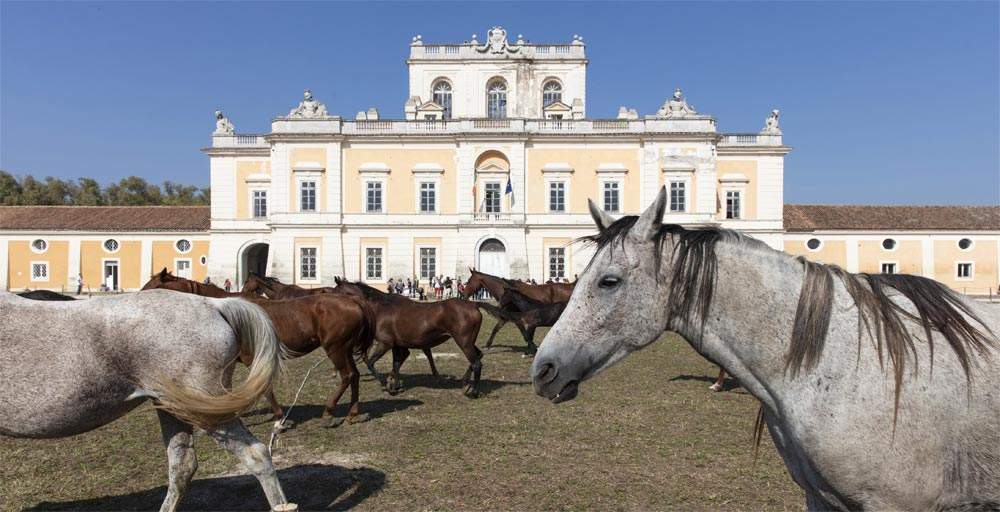Horseback riding and historical re-enactments to enhance the Reggia di Carditello? This seems to be the idea of the chairman of the Culture, Science and Education Commission of the Chamber of Deputies, Federico Mollicone, who visited the Royal Site of Carditello (San Tammaro, Caserta) on Friday, reaffirming the government’s commitment to the ultimate revitalization of the Bourbon Royal Palace during the meeting between the delegation (composed of Mollicone and the Honorable Gerolamo Cangiano), the president of the Real Sito di Carditello Foundation, Maurizio Maddaloni, and the board members.
Indeed, one of the main features of the Reggia is the presence of horses of the Persano Governative Breed, the prized breed of state horses born in 1744 at the behest of King Charles of Bourbon, the result of a cross between Turkish stallions and mares from the Kingdom of Naples. Born as war horses, they were among the most prized of their time, for their elegance and strength (the prancing horse of Ferrari is also a Persano horse: in fact, Enzo Ferrari received one as a gift from Countess Paolina Baracca, mother of Francesco Baracca, who fought during World War I with the image of the prancing horse on the fuselage of his plane. The breeding of Persano horses was aimed at the establishment of a highly prestigious Royal Cavalry, with specimens characterized by endurance, courage and elegance.King Charles of Bourbon received 4 Turkish stallions as a gift from Sultan Mahmoud II, and in 1744 he leased land, already identified by Viceroy Michele Reggio, in the Capua plain and more precisely in the San Tammaro district: the Carditello farm. This vast area, rich and fertile, had also been used for years for hunting as well as agricultural production. The Carditello we know today is precisely the fruit of the project commissioned by Ferdinand IV in 1787, with the clear intent of breeding, selecting and showcasing Persano horses, treated with every consideration and jealously guarded by the Bourbons. King Ferdinand IV arranged for shelters and stables, as well as a hippodrome that was the first to be built in Italy and the only one to be included within an architectural complex, which became a Royal Residence exclusively because of the importance these horses had.
An importance that the current government intends to reaffirm. “Carditello,” Mollicone stressed, “has a precise natural vocation for equestrian art, linked to the history of Persano horses. A value that we intend to confirm and strengthen in collaboration with the Army, the Italian Equestrian Sports Federation and other entities related to the equestrian sector. For this reason, we are working hard with the new governance of the Foundation so that it can identify accessible funds to strengthen this great tradition, including through a program of events dedicated to historical re-enactments. It is important to mention that this fund has already been doubled and a new edition will soon start with more resources and different criteria, open precisely to institutional realities such as Carditello.”
“There is the government’s commitment to the definitive revitalization of the Royal Site of Carditello,” added Congressman Cangiano. “It is no coincidence that an order of the day has been approved, signed by me and my colleagues Cerreto and Zinzi, through which the executive is committed to evaluating the redevelopment of the Royal Palace of Carditello, also considering the promotion of specific legislative initiatives, related to urban and energy regeneration processes.”
The Royal Site of Carditello, in addition to representing a remarkable historical, artistic and environmental heritage, is proposed to become a planning control room for the territory. “The visit of the Cultural Commission of the Chamber of Deputies, on the day after the first installation of the Foundation’s new Board of Directors,” explains the Foundation’s president, Maurizio Maddaloni, “is a sign of great attention for the Real Site of Carditello and for the entire territory. Carditello can be an important driver of development in terms of culture, tourism and economy. There is all the potential to become, once the restoration work is completed, a virtuous model for the Caserta and regional territory. The goal now is to develop institutional synergies and define a strategy to enhance the circuit of the Bourbon royal sites and attract international visitors.”
The Royal Site of Carditello, after being considered for decades the symbol of degradation and abandonment in the Terra dei Fuochi, was purchased in 2014 by the state thanks to the efforts of then-Minister of Cultural Heritage Massimo Bray, and today it is a model of redemption for the entire community, open to families and children.
“I thank the chairman of the Culture Commission and the Honorable Cangiano for the institutional visit,” concluded the mayor of San Tammaro, Vincenzo D’Angelo. “We are grateful for the attention they have shown, which testifies to a sign of redemption for the entire territory. On the part of the administration, as always, we will be close to the Board of Trustees of the Real Sito di Carditello Foundation, working synergistically for the revitalization of the site.”
 |
| Horseback riding and historical re-enactments to enhance the Carditello Palace? |
Warning: the translation into English of the original Italian article was created using automatic tools. We undertake to review all articles, but we do not guarantee the total absence of inaccuracies in the translation due to the program. You can find the original by clicking on the ITA button. If you find any mistake,please contact us.